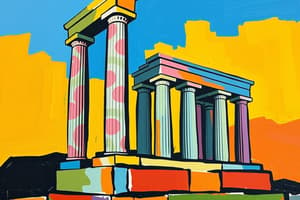Podcast
Questions and Answers
What is depicted in the Victory Monument of Attolos I?
What is depicted in the Victory Monument of Attolos I?
- A peaceful female figure
- A Gaul killing himself (correct)
- A battle scene
- A victorious warrior
What key characteristics define the Dying Gaul?
What key characteristics define the Dying Gaul?
Twisted rope-celtic identification, baroque body language, exaggerated male features.
What does the term 'tubicen' refer to?
What does the term 'tubicen' refer to?
Trumpeters.
What are the main features of the Seated Boxer?
What are the main features of the Seated Boxer?
What does the Old Market Woman sculpture represent?
What does the Old Market Woman sculpture represent?
What themes are associated with the Aphrodite of Melos?
What themes are associated with the Aphrodite of Melos?
What does the Winged Nike of Samothrace symbolize?
What does the Winged Nike of Samothrace symbolize?
What is a characteristic of Hellenistic statues?
What is a characteristic of Hellenistic statues?
What event does Laocoon depict?
What event does Laocoon depict?
What was notable about the Battle of Issus mosaic?
What was notable about the Battle of Issus mosaic?
What is significant about the Temple of Apollo?
What is significant about the Temple of Apollo?
What historical context surrounds the Alexander Sarcophagus?
What historical context surrounds the Alexander Sarcophagus?
What does the Gallic chieftain killing himself and his wife sculpture emphasize?
What does the Gallic chieftain killing himself and his wife sculpture emphasize?
In which ways is the sculpture and architecture of the Late Classical Period a break away from the Classical Greek Style?
In which ways is the sculpture and architecture of the Late Classical Period a break away from the Classical Greek Style?
In which ways is the sculpture and architecture of the Hellenistic Period a break away from the Classical Greek Style and Late Classical Style?
In which ways is the sculpture and architecture of the Hellenistic Period a break away from the Classical Greek Style and Late Classical Style?
What is Plato's cave?
What is Plato's cave?
Who are the three main playwrights associated with Greek Tragedy?
Who are the three main playwrights associated with Greek Tragedy?
Who was Socrates?
Who was Socrates?
What is the orchestra in Greek Theater?
What is the orchestra in Greek Theater?
What is a proscenium?
What is a proscenium?
What is skene?
What is skene?
What is theatron?
What is theatron?
What is Pergamon known for in terms of artistic development?
What is Pergamon known for in terms of artistic development?
Who was Attalos I?
Who was Attalos I?
Who were the Gauls?
Who were the Gauls?
What is the phalanx?
What is the phalanx?
What did Alexander the Great achieve?
What did Alexander the Great achieve?
Who was Apelles?
Who was Apelles?
Who was Ptolemy?
Who was Ptolemy?
What does the term 'orchestra' refer to in a Greek theater?
What does the term 'orchestra' refer to in a Greek theater?
The __________ was a defining architectural feature of Greek theaters, where performances took place.
The __________ was a defining architectural feature of Greek theaters, where performances took place.
An __________ is a term used to describe a compact military formation in ancient Greek warfare.
An __________ is a term used to describe a compact military formation in ancient Greek warfare.
What were the two prominent styles of vase painting in ancient Greece?
What were the two prominent styles of vase painting in ancient Greece?
What are Kouroi statues used for?
What are Kouroi statues used for?
How was the human figure represented in the archaic and early Classical periods?
How was the human figure represented in the archaic and early Classical periods?
What does the Archaic smile signify?
What does the Archaic smile signify?
What is the 'Pudica Pose'?
What is the 'Pudica Pose'?
What were the benefits of the red-figure technique in vase painting?
What were the benefits of the red-figure technique in vase painting?
What is a tholos tomb?
What is a tholos tomb?
Flashcards are hidden until you start studying
Study Notes
Late Classical and Hellenistic Greek Art
- Late Classical art marks a departure from Classical Greek ideals, introducing more emotional expression and a focus on the individual.
- The Hellenistic period shifts further towards the depiction of everyday mortals, emotional drama, and dynamic poses.
Key Artists and Philosophers
- Plato: An influential philosopher and student of Socrates, proposed that the physical world is a mere shadow of reality.
- Socrates: Believed in the value of integrity and honor over wealth, emphasizing the importance of ethical living.
Greek Tragedy and Theater
- Major playwrights include Aeschylus, Sophocles, and Euripides, with their works commonly performed during festivals honoring Dionysos.
- Significant elements of Greek theater include the orchestra for the chorus, the proscenium stage, and the skene, which served as both a backdrop and dressing area.
Architectural Developments
- Pergamon emerged as a center for Hellenistic art, embracing anti-classical styles.
- The Corinthian Order represents the most ornate architectural style, distinguished by elaborate capitals with leaf decorations.
Historical Figures
- Attalos I defeated the Gauls in 230 BCE and led Pergamon into a period of artistic innovation.
- Alexander the Great (334-323 BCE) is credited with spreading Greek culture across the Middle East through his extensive conquests.
Sculpture and Artistic Techniques
- Notable Hellenistic sculptures include "Dying Gaul," "Laocoon and His Sons," and the "Altar of Zeus" from Pergamon.
- Innovations such as foreshortening and the use of tesserae in mosaics enhance visual dramatic effects in artworks.
Differences in Artistic Technique
- Black-figure technique involves incising figures onto clay vases, while red-figure technique allows for greater detail and naturalism through brushwork.
- Late Classical and Hellenistic sculptors deviated from High Classical styles by introducing more dynamic compositions and emotional expressions.
Cultural Context
- The Hellenistic era was characterized by expansion, trade, and warfare, profoundly influencing art's subject matter and stylistic elements.
- Minoan and Mycenaean art featured innovations that laid groundwork for later Classical artistic developments.
Notable Works and Artforms
- The "Alexander Mosaic," depicting the Battle of Issus, is a significant artwork demonstrating the use of drama and movement.
- The "Aphrodite of Knidos," by Praxiteles, sparked debates about female representation and modesty in Greek art.
Architectural Features
- Doric temples feature thick columns with simple capitals, while the cella is the temple’s inner chamber housing the cult statue.
- Hypaethral structures are open to the air, allowing natural light and environmental elements to play a role in the space's atmosphere.
Societal Reflections
- The design of Minoan palaces suggests a complex society engaged in extensive trade and possessing social hierarchies.
- Greek art often symbolizes ideals of beauty, proportion, and human form, reflecting cultural values and aesthetic standards of the time.### Exaggerated Male Features
- Refers to artistic representations emphasizing masculine traits, often to convey strength or heroism in sculptures and paintings.
Tubicen
- Means "trumpeters," often seen in artwork depicting musicians or heralds in ancient settings.
Seated Boxer
- Represents an athlete with a tired, detailed facial expression, showcasing realism in Hellenistic art.
Old Market Woman
- Portrays age and realism, highlighting social class as a servant/slave woman, with a focus on her physical attributes tied to her past.
Aphrodite of Melos
- Considered early pornography, features suggestive sexual postures while the expression remains emotionless.
Winged Nike of Samothrace
- Symbolizes the crowning of a victor in a naval battle; it deviates from idealized proportions, emphasizing movement and dynamism.
Hellenistic Statues
- Notably interact with their environment, displaying a sense of realism and viewer engagement.
Laocoon
- Depicts the moment Poseidon kills Laocoon and his sons, related to the Trojan War and comparable to the Dying Gaul in emotion and realism.
Battle of Issus
- Hellenistic artwork (323-30 BC) created by Philoxenos of Eretria around 310 BC; utilizes tessera mosaic technique showcasing artistic mastery in foreshortening, color modeling, and intensity of battle.
Temple of Apollo
- Open-air hypaethral temple located in Didyma, Turkey, built in 313 BC; breaks traditional Greek temple design rules and created by architects Paionios of Ephesos and Daphnis of Miletos.
Alexander Sarcophagus
- Found in Saida, Lebanon, dates back to the late 4th century BC; designed as a Greek temple with depictions of Persian and Greek battles and hunting scenes, highlighting cultural interactions through realism and attire contrasts.
Gallic Chieftain Killing Himself and His Wife
- A work by Epigonos from Pergamon, Turkey, dating 230-220 BC; features intricate human anatomy and a focus on realism, reflecting deep emotional themes.
Studying That Suits You
Use AI to generate personalized quizzes and flashcards to suit your learning preferences.




